Rhombille tiling
| Rhombille tiling | |
|---|---|
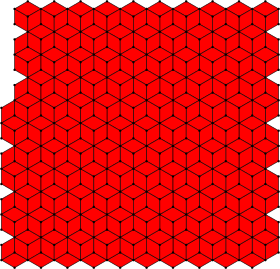 | |
| Type | Laves tiling |
| Coxeter diagram | |
| Faces | 60°–120° rhombus |
| Face configuration | V3.6.3.6 |
| Symmetry group | p6m, [6,3], *632 p3m1, [3[3]], *333 |
| Rotation group | p6, [6,3]+, (632) p3, [3[3]]+, (333) |
| Dual | Trihexagonal tiling |
| Properties | edge-transitive face-transitive |
In geometry, the rhombille tiling,[1] also known as tumbling blocks,[2] reversible cubes, or the dice lattice, is a tessellation of identical 60° rhombi on the Euclidean plane. Each rhombus has two 60° and two 120° angles; rhombi with this shape are sometimes also called diamonds. Sets of three rhombi meet at their 120° angles and sets of six rhombi meet at their 60° angles.
Properties
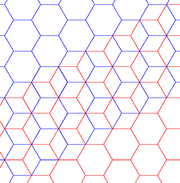

The rhombille tiling can be seen as a subdivision of a hexagonal tiling with each hexagon divided into three rhombi meeting at the center point of the hexagon. This subdivision represents a regular compound tiling. It can also be seen as a subdivision of four hexagonal tilings with each hexagon divided into 12 rhombi.
The diagonals of each rhomb are in the ratio 1:√3. This is the dual tiling of the trihexagonal tiling or kagome lattice. As the dual to a uniform tiling, it is one of eleven possible Laves tilings, and in the face configuration for monohedral tilings it is denoted [3.6.3.6].[4]
It is also one of 56 possible isohedral tilings by quadrilaterals,[5] and one of only eight tilings of the plane in which every edge lies on a line of symmetry of the tiling.[6]
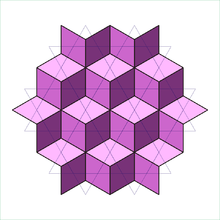
It is possible to embed the rhombille tiling into a subset of a three-dimensional integer lattice, consisting of the points (x,y,z) with |x + y + z| ≤ 1, in such a way that two vertices are adjacent if and only if the corresponding lattice points are at unit distance from each other, and more strongly such that the number of edges in the shortest path between any two vertices of the tiling is the same as the Manhattan distance between the corresponding lattice points. Thus, the rhombille tiling can be viewed as an example of an infinite unit distance graph and partial cube.[7]
Artistic and decorative applications
The rhombille tiling can be interpreted as an isometric projection view of a set of cubes in two different ways, forming a reversible figure related to the Necker Cube. In this context it is known as the "reversible cubes" illusion.[8]
In the M. C. Escher artworks Metamorphosis I, Metamorphosis II, and Metamorphosis III Escher uses this interpretation of the tiling as a way of morphing between two- and three-dimensional forms.[9] In another of his works, Cycle (1938), Escher played with the tension between the two-dimensionality and three-dimensionality of this tiling: in it he draws a building that has both large cubical blocks as architectural elements (drawn isometrically) and an upstairs patio tiled with the rhombille tiling. A human figure descends from the patio past the cubes, becoming more stylized and two-dimensional as he does so.[10] These works involve only a single three-dimensional interpretation of the tiling, but in Convex and Concave Escher experiments with reversible figures more generally, and includes a depiction of the reversible cubes illusion on a flag within the scene.[11]
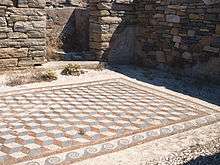
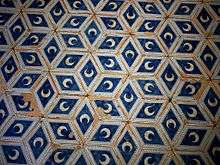
The rhombille tiling is also used as a design for parquetry[12] and for floor or wall tiling, sometimes with variations in the shapes of its rhombi.[13] It appears in ancient Greek floor mosaics from Delos[14] and from Italian floor tilings from the 11th century,[15] although the tiles with this pattern in Siena Cathedral are of a more recent vintage.[16] In quilting, it has been known since the 1850s as the "tumbling blocks" pattern, referring to the visual dissonance caused by its doubled three-dimensional interpretation.[2][15][17] As a quilting pattern it also has many other names including cubework, heavenly stairs, and Pandora's box.[17] It has been suggested that the tumbling blocks quilt pattern was used as a signal in the Underground Railroad: when slaves saw it hung on a fence, they were to box up their belongings and escape.[18] In these decorative applications, the rhombi may appear in multiple colors, but are typically given three levels of shading, brightest for the rhombs with horizontal long diagonals and darker for the rhombs with the other two orientations, to enhance their appearance of three-dimensionality. There is a single known instance of implicit rhombille and trihexagonal tiling in English heraldry – in the Geal/e arms.[19]
Other applications
The rhombille tiling may be viewed as the result of overlaying two different hexagonal tilings, translated so that some of the vertices of one tiling land at the centers of the hexagons of the other tiling. Thus, it can be used to define block cellular automata in which the cells of the automaton are the rhombi of a rhombille tiling and the blocks in alternating steps of the automaton are the hexagons of the two overlaid hexagonal tilings. In this context, it is called the "Q*bert neighborhood", after the video game Q*bert which featured an isometric view of a pyramid of cubes as its playing field. The Q*bert neighborhood may be used to support universal computation via a simulation of billiard ball computers.[20]
In condensed matter physics, the rhombille tiling is known as the dice lattice, diced lattice, or dual kagome lattice. It is one of several repeating structures used to investigate Ising models and related systems of spin interactions in diatomic crystals,[21] and it has also been studied in percolation theory.[22]
Symmetry
The rhombille tiling has *632 symmetry, but vertices can be colored with alternating colors on the inner points leading to a *333 symmetry.
| Image |  (2 colors) |
 (3 colors) |
|---|---|---|
| Symmetry | p6m, [6,3], (*632) | p3m1, [3[3]], (*333) |
| Coxeter |
Related polyhedra and tilings
The rhombille tiling is the dual of the trihexagonal tiling, and as such is part of a set of uniform dual tilings. It is also a part of a sequence of rhombic polyhedra and tilings with [n,3] Coxeter group symmetry, starting from the cube, which can be seen as a rhombic hexahedron where the rhombi are squares. The nth element in this sequence has a face configuration of V3.n.3.n.
| Symmetry mutations of dual quasiregular tilings: V(3.n)2 | |||||||||||
|---|---|---|---|---|---|---|---|---|---|---|---|
| *n32 | Spherical | Euclidean | Hyperbolic | ||||||||
| *332 | *432 | *532 | *632 | *732 | *832... | *∞32 | |||||
| Tiling |  |
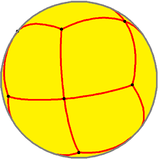 |
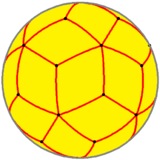 |
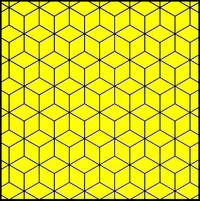 |
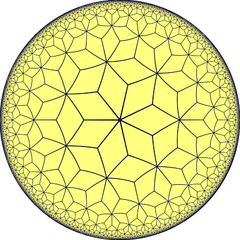 |
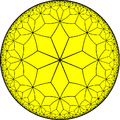 |
 | ||||
| Conf. | V(3.3)2 | V(3.4)2 | V(3.5)2 | V(3.6)2 | V(3.7)2 | V(3.8)2 | V(3.∞)2 | ||||
The rhombille tiling is one of many different ways of tiling the plane by congruent rhombi. Others include a diagonally flattened variation of the square tiling (with translational symmetry on all four sides of the rhombi), the tiling used by the Miura-ori folding pattern (alternating between translational and reflectional symmetry), and the Penrose tiling which uses two kinds of rhombi with 36° and 72° acute angles aperiodically. When more than one type of rhombus is allowed, additional tilings are possible, including some that are topologically equivalent to the rhombille tiling but with lower symmetry.
 |
 |
See also
| Wikimedia Commons has media related to Rhombille tiling. |
References
- ↑ Conway, John; Burgiel, Heidi; Goodman-Strass, Chaim (2008), "Chapter 21: Naming Archimedean and Catalan polyhedra and tilings", The Symmetries of Things, AK Peters, p. 288, ISBN 978-1-56881-220-5.
- 1 2 Smith, Barbara (2002), Tumbling Blocks: New Quilts from an Old Favorite, Collector Books, ISBN 9781574327892.
- ↑ Richard K. Guy & Robert E. Woodrow, The Lighter Side of Mathematics: Proceedings of the Eugène Strens Memorial Conference on Recreational Mathematics and its History, 1996, p.79, Figure 10
- ↑ Grünbaum, Branko; Shephard, G. C. (1987), Tilings and Patterns, New York: W. H. Freeman, ISBN 0-7167-1193-1. Section 2.7, Tilings with regular vertices, pp. 95–98.
- ↑ Grünbaum & Shephard (1987), Figure 9.1.2, Tiling P4-42, p. 477.
- ↑ Kirby, Matthew; Umble, Ronald (2011), "Edge tessellations and stamp folding puzzles", Mathematics Magazine, 84 (4): 283–289, arXiv:0908.3257
 , doi:10.4169/math.mag.84.4.283, MR 2843659.
, doi:10.4169/math.mag.84.4.283, MR 2843659. - ↑ Deza, Michel; Grishukhin, Viatcheslav; Shtogrin, Mikhail (2004), Scale-isometric polytopal graphs in hypercubes and cubic lattices: Polytopes in hypercubes and Zn, London: Imperial College Press, p. 150, doi:10.1142/9781860945489, ISBN 1-86094-421-3, MR 2051396.
- ↑ Warren, Howard Crosby (1919), Human psychology, Houghton Mifflin, p. 262.
- ↑ Kaplan, Craig S. (2008), "Metamorphosis in Escher's art", Bridges 2008: Mathematical Connections in Art, Music and Science (PDF), pp. 39–46.
- ↑ Escher, Maurits Cornelis (2001), M.C. Escher, the Graphic Work, Taschen, pp. 29–30, ISBN 9783822858646.
- ↑ De May, Jos (2003), "Painting after M. C. Escher", in Schattschneider, D.; Emmer, M., M. C. Escher's Legacy: A Centennial Celebration, Springer, pp. 130–141.
- ↑ Schleining, Lon; O'Rourke, Randy (2003), "Tricking the eyes with tumbling blocks", Treasure Chests: The Legacy of Extraordinary Boxes, Taunton Press, p. 58, ISBN 9781561586516.
- ↑ Tessellation Tango, The Mathematical Tourist, Drexel University, retrieved 2012-05-23.
- ↑ Dunbabin, Katherine M. D. (1999), Mosaics of the Greek and Roman World, Cambridge University Press, p. 32, ISBN 9780521002301.
- 1 2 Tatem, Mary (2010), "Tumbling Blocks", Quilt of Joy: Stories of Hope from the Patchwork Life, Revell, p. 115, ISBN 9780800733643.
- ↑ Wallis, Henry (1902), Italian ceramic art, Bernard Quaritch, p. xxv.
- 1 2 Fowler, Earlene (2008), Tumbling Blocks, Benni Harper Mysteries, Penguin, ISBN 9780425221235. This is a mystery novel, but it also includes a brief description of the tumbling blocks quilt pattern in its front matter.
- ↑ Tobin, Jacqueline L.; Dobard, Raymond G. (2000), Hidden in Plain View: A Secret Story of Quilts and the Underground Railroad, Random House Digital, Inc., p. 81, ISBN 9780385497671.
- ↑ Aux armes: symbolism, Symbolism in arms, Pleiade, retrieved 2013-04-17.
- ↑ The Q*Bert neighbourhood, Tim Tyler, accessed 2012-05-23.
- ↑ Fisher, Michael E. (1959), "Transformations of Ising models", Physical Review, 113 (4): 969–981, doi:10.1103/PhysRev.113.969.
- ↑ Yonezawa, Fumiko; Sakamoto, Shoichi; Hori, Motoo (1989), "Percolation in two-dimensional lattices. I. A technique for the estimation of thresholds", Phys. Rev. B, 40 (1): 636–649, doi:10.1103/PhysRevB.40.636.
Additional reading
- Keith Critchlow, Order in Space: A design source book, 1970, pp.77–76, pattern 1
